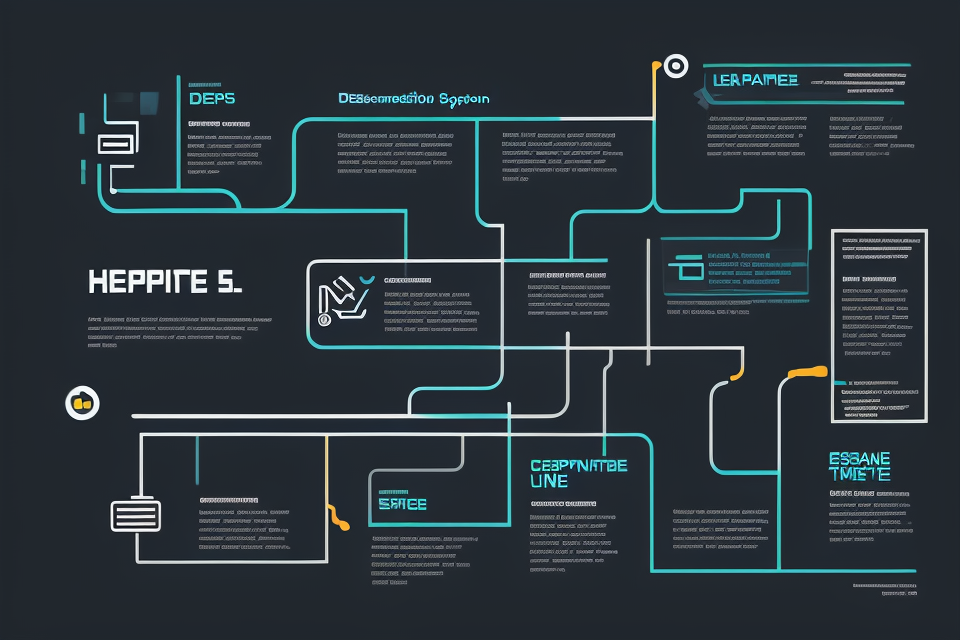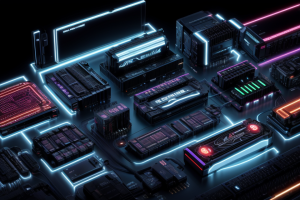
Hardware specifications are the detailed description of the components and features of a computer system or electronic device. It includes information such as the processor speed, RAM size, storage capacity, graphics card, and other peripherals. Understanding hardware specifications is crucial when making purchasing decisions, as it can affect the performance and capabilities of the device. In this comprehensive guide, we will explore the different hardware specifications and their significance in the functioning of a computer system. We will also discuss how to interpret and compare specifications to make informed decisions when buying a new device. So, let’s dive in and discover the world of hardware specifications!
What are hardware specifications?
Definition and purpose
Hardware specifications refer to the detailed description of the technical characteristics of a computer system or device. These specifications define the components, capabilities, and performance of a device, and they are essential for understanding the system’s behavior and potential applications.
The purpose of hardware specifications is to provide a clear and accurate representation of a device’s capabilities, allowing users, developers, and manufacturers to make informed decisions about system design, compatibility, and performance. Hardware specifications also help users to understand the limitations and potential of a device, ensuring that they can use it effectively and efficiently.
In addition, hardware specifications are crucial for the tech industry as they provide a standardized way of describing devices and their capabilities. This standardization makes it easier for manufacturers to create compatible devices and for users to compare different products and make informed purchasing decisions. Overall, hardware specifications play a critical role in the tech industry by providing a clear and consistent way of describing devices and their capabilities.
Types of hardware specifications
Hardware specifications refer to the detailed information about the various components that make up a computer system. These specifications provide users with information about the capabilities of a computer, including its processing power, memory, storage, and other features. Understanding hardware specifications is essential for making informed decisions when purchasing a computer or upgrading existing hardware.
There are several types of hardware specifications that are important to consider when evaluating a computer system. These include:
- CPU specifications: The CPU, or central processing unit, is the brain of a computer system. CPU specifications include information about the processor’s clock speed, number of cores, and architecture. The clock speed, or frequency, of a processor is measured in GHz (gigahertz) and determines how many instructions the processor can execute per second. The number of cores refers to the number of independent processing units within the CPU. CPU architecture refers to the design of the processor and can affect its performance and compatibility with different software programs.
- RAM specifications: RAM, or random access memory, is a type of memory that is used to temporarily store data while a computer is running. RAM specifications include information about the amount of memory installed in the computer, as well as the type and speed of the memory. The amount of RAM installed can affect the computer’s performance, particularly when running multiple applications or programs. The type and speed of the memory can also impact performance and may determine which operating systems and software programs are compatible with the computer.
- Storage specifications: Storage specifications refer to the type and amount of storage available in a computer system. This includes information about the hard drive or solid state drive (SSD), as well as any additional storage devices such as USB drives or external hard drives. The type of storage can affect the speed at which data is accessed and transferred. The amount of storage can impact the amount of data that can be stored on the computer and may determine the size of files that can be opened or saved.
- GPU specifications: The GPU, or graphics processing unit, is responsible for rendering images and handling graphical processing tasks. GPU specifications include information about the type and speed of the graphics card, as well as the amount of video memory (VRAM) available. The type and speed of the graphics card can impact the performance of the computer when running graphics-intensive applications or games. The amount of VRAM can affect the performance of the graphics card and may determine the size and complexity of the graphics that can be rendered.
- Other hardware specifications: In addition to the components listed above, there are many other hardware specifications that may be important when evaluating a computer system. These can include information about the type and number of USB ports, display resolution, network connectivity, and other features. Understanding these specifications can help users determine the capabilities of a computer and make informed decisions when purchasing or upgrading hardware.
How to read hardware specifications
Hardware specifications are essential for understanding the technical characteristics of a computer system or device. These specifications provide information about the components, capabilities, and performance of a device, and they are crucial for making informed decisions about system design, compatibility, and performance. Understanding hardware specifications is essential for making informed decisions when purchasing or upgrading hardware. To understand hardware specifications, it is important to decode technical jargon and compare hardware specifications to make informed decisions. Factors to consider when selecting hardware specifications include budget, usage needs, and compatibility with software and peripherals. Emerging trends and technologies such as artificial intelligence, machine learning, virtual and augmented reality, 5G, and IoT are shaping the future of hardware specifications. As technology continues to advance, hardware specifications will evolve, which could have significant implications for both consumers and the industry as a whole.
Decoding technical jargon
Decoding technical jargon is an essential part of understanding hardware specifications. Technical specifications can be full of unfamiliar terms and abbreviations, but it’s crucial to understand them to make informed decisions when purchasing hardware. Here are some tips for decoding technical jargon:
- Look up unfamiliar terms: If you come across a term you don’t understand, look it up. There are many resources available online, including technical dictionaries and forums where you can ask for help.
- Check the context: Technical specifications are often written in a specific context, so it’s important to understand the context in which a term is used. For example, the term “GHz” refers to the frequency at which a processor runs, but it only makes sense in the context of processors.
- Use the internet: The internet is a great resource for understanding technical specifications. Websites like AnandTech and TomsHardware provide detailed explanations of hardware specifications, as well as reviews and benchmarks.
- Read the entire specification: It’s important to read the entire specification, not just the headline specifications. The headline specifications, such as clock speed and memory size, are often the most important, but the fine print can provide important details about the hardware’s capabilities.
- Understand the units of measurement: Hardware specifications are often written in technical units of measurement, such as MHz or Gbps. It’s important to understand these units of measurement to understand the hardware’s capabilities.
By following these tips, you can decode technical jargon and understand hardware specifications better. Understanding hardware specifications is essential for making informed decisions when purchasing hardware, and it can also help you troubleshoot hardware issues and optimize hardware performance.
Comparing hardware specifications
When it comes to comparing hardware specifications, there are several key factors to consider. These include:
- Performance: This refers to the ability of the hardware to perform tasks, such as processing speed, memory capacity, and storage space. It’s important to compare these specs across different models to determine which one is best suited for your needs.
- Compatibility: It’s also important to consider whether the hardware you’re comparing is compatible with your existing system or devices. For example, if you’re looking to upgrade your graphics card, you’ll want to make sure it’s compatible with your current motherboard and power supply.
- Price: Of course, cost is always a factor when it comes to hardware purchases. It’s important to compare prices across different models to determine which one offers the best value for your money.
One useful tool for comparing hardware specifications is benchmarks and performance ratings. These tests measure the hardware’s ability to perform specific tasks, such as gaming or video editing, and can help you compare different models in a more objective way. However, it’s important to keep in mind that benchmarks and performance ratings are just one part of the equation, and that real-world performance may vary depending on a variety of factors.
Choosing the right hardware specifications
Factors to consider
When selecting hardware specifications, several factors must be considered to ensure that the chosen components meet the user’s needs and budget. Here are some key factors to keep in mind:
- Budget: The amount of money available for purchasing hardware is an essential factor to consider. Setting a budget can help narrow down the options and avoid overspending. It is crucial to balance the budget with the desired performance, as a higher budget does not always guarantee better performance.
- Usage needs: The intended use of the hardware is another critical factor. Different applications require different specifications. For example, gaming needs a powerful graphics card and a fast processor, while video editing requires a high-speed storage and a fast processor. It is important to understand the specific requirements of the user’s tasks to choose the right hardware.
- Compatibility with software and peripherals: The hardware must be compatible with the software and peripherals that the user plans to use. For example, if the user intends to use a specific brand of keyboard or mouse, they should ensure that the computer’s ports are compatible with those devices. Additionally, some software may have minimum hardware requirements to run smoothly, so it is important to check for compatibility before making a purchase.
Tips for making informed decisions
Researching and comparing different products
One of the most important things to do when trying to make an informed decision about hardware specifications is to research and compare different products. This means looking at different models and brands, and comparing their specifications and features. It is important to compare products that are similar in price and intended use, so that you can make an accurate comparison. This will help you to determine which products offer the best value for money, and which ones have the specifications that are most important to you.
Reading reviews and customer feedback
Another important tip for making informed decisions about hardware specifications is to read reviews and customer feedback. This can give you a good idea of how well a product performs in real-world situations, and can help you to identify any potential issues or drawbacks. It is important to read reviews from a variety of sources, including professional reviewers and regular customers, to get a well-rounded view of a product’s strengths and weaknesses.
Consulting with experts and online forums
Finally, it can be helpful to consult with experts and online forums when trying to make an informed decision about hardware specifications. This can include computer technicians, hardware engineers, and other professionals who have expertise in this area. Online forums and discussion boards can also be a valuable resource, as they allow you to tap into the collective knowledge and experience of other users. By consulting with experts and online communities, you can get a better understanding of the pros and cons of different hardware specifications, and make a more informed decision.
Future of hardware specifications
Emerging trends and technologies
The world of technology is constantly evolving, and the field of hardware specifications is no exception. As new trends and technologies emerge, hardware specifications must adapt to keep up. In this section, we will explore some of the emerging trends and technologies that are shaping the future of hardware specifications.
Artificial intelligence and machine learning
Artificial intelligence (AI) and machine learning (ML) are two of the most significant emerging trends in the tech industry. These technologies are increasingly being integrated into hardware specifications, allowing devices to become more intelligent and capable. For example, AI and ML can be used to optimize the performance of a device, improve its energy efficiency, and enhance its security. As AI and ML continue to advance, we can expect to see them play an even more significant role in hardware specifications.
Virtual and augmented reality
Virtual reality (VR) and augmented reality (AR) are two other emerging trends that are having a significant impact on hardware specifications. VR and AR technologies require a high degree of computational power and memory to function effectively. As a result, hardware specifications for VR and AR devices must be carefully designed to ensure that they can deliver the required performance. In addition, VR and AR devices often require specialized sensors and input devices, such as motion controllers and eye-tracking technology, which must be carefully integrated into the hardware specification.
5G and IoT
The fifth-generation wireless network (5G) and the Internet of Things (IoT) are two more emerging trends that are shaping the future of hardware specifications. 5G is a new wireless network standard that promises faster speeds, lower latency, and greater capacity than previous generations. This will enable new applications and services, such as autonomous vehicles, smart cities, and remote healthcare. The IoT, on the other hand, refers to the growing network of connected devices that can collect and share data over the internet. As the number of IoT devices continues to grow, hardware specifications must be designed to support their unique requirements, such as low power consumption, long battery life, and secure data transmission.
Overall, these emerging trends and technologies are driving the evolution of hardware specifications, and will continue to shape the future of the industry. As a result, it is essential for hardware engineers and designers to stay up-to-date with these developments in order to create innovative and effective products.
Implications for consumers and industry
As technology continues to advance, it is likely that hardware specifications will evolve as well. These changes could have significant implications for both consumers and the industry as a whole.
For consumers, the increasing complexity of hardware specifications may make it more difficult to make informed purchasing decisions. It may be necessary for consumers to become more familiar with technical terms and concepts in order to understand the differences between various products. Additionally, as new technologies are developed, consumers may need to consider whether or not to upgrade their existing hardware in order to take advantage of new features and capabilities.
For the industry, changes in hardware specifications could lead to shifts in market demand and consumer behavior. As new technologies become available, manufacturers may need to adapt their products to meet the changing needs of consumers. This could result in a shift away from traditional hardware formats and towards more specialized or niche products. Additionally, the increasing complexity of hardware specifications may require manufacturers to invest more in research and development in order to keep up with changing industry standards.
FAQs
1. What are hardware specifications?
Hardware specifications refer to the physical attributes and capabilities of a computer system or device. These specifications include details such as the processor speed, amount of RAM, storage capacity, graphics card, and other components that determine the overall performance and functionality of the device.
2. Why are hardware specifications important?
Hardware specifications are important because they determine the capabilities and performance of a computer system or device. Understanding the hardware specifications of a device can help users make informed decisions when choosing a device that meets their needs, whether it’s for personal or







